#defunct airlines
Text
No. 15 - PSA (Pacific Southwest Airlines)

Thank you to @lobstersinmyhouse for requesting PSA! And, in all honesty, this is exactly my feelings too. Pack it up, post over.
...okay, no. I am going to write a post, but I make no secret of loving PSA's airplanes. After all, one is even my icon.

image: Piergiuliano Chesi
There was never an airline like it before PSA sprang up in 1949, and there has never been an airline like it since. Decades after its demise I still feel a real sense of grief about the fact that it's gone. Pacific Southwest Airlines hasn't existed for longer than its entire time in operation and it mostly only operated in a single state, but it remains one of the most beloved airlines ever to exist. I'm certainly far from immune to catching their smile. So I'm very, very excited to cover the iconic grinningbirds, one of the best-known airline liveries of all time even 40 years after the regional carrier which wore it ceased existing.
youtube
PSA officially stands for Pacific Southwest Airlines. Unofficially, it was the Poor Sailor's Airline. According to a button they put out, it was this.

image: psa-history.org
But really, it can stand for anything you want. I think it stands for Pretty Smiling Airplanes.
You see, PSA's marketing leaned into the fun and casual as much as it was possible for an airline to do. They called themselves "The World's Friendliest Airline". Their branding was all bright, colorful, delightful. One aspect of it is particularly well known.
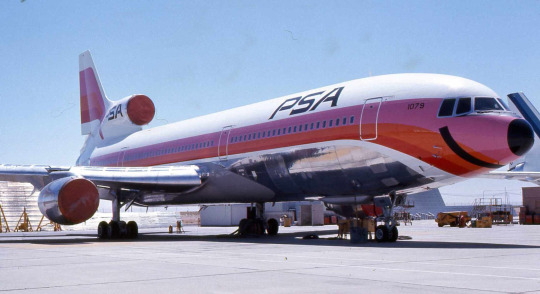
image: Piergiuliano Chesi
The name "grinningbird" is literal. PSA's fleet was lovingly painted with massive smiles directly under their noses. Their advertisements encouraged people to "catch our smile" across the state of California.

A preserved DC-3 in original Pacific Southwest livery
PSA was started as a single leased DC-3 hopping from San Diego to Oakland. Apparently their ticket office was literally a refitted military surplus latrine where they weighed passenger baggage on a bathroom scale. When they expanded with DC-4s they painted rectangles around the windows to make them look more like DC-6s. This was in 1955. And then, by the early 60s, they were taking off.
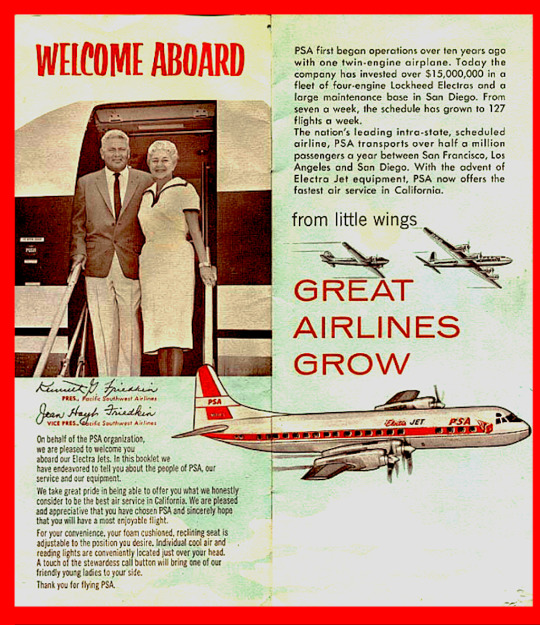

A pre-smile PSA Electra. The L-188 Electra is, of course, my favorite jet plane.
image: Jon Proctor
It was in the 60s that their planes stopped saying 'Pacific Southwest Airlines' and started just being PSA, and it was in the 60s when they caught their smiles. This was the point when PSA became PSA, transforming from just another intrastate airline in the pre-deregulation era to a turning point in aviation history.
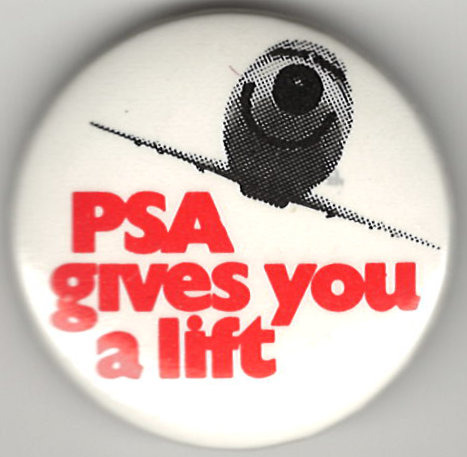
a 1972 promotional button
image: psa-history.org
While the smiley faces are the most significant historical fact about PSA, also notable is the fact that they were the first low-cost carrier in history. Although PSA's routes were limited to Southern California, they charged $9.99 for a ticket other airlines would charge $13.50 or $22.05 for - and keep in mind that in today's money that's a difference of hundreds of dollars. Free of federal fare taxes and operating frequently, PSA grew at an intense pace with its new fleet of Lockheed L-188 Electras.

I love the L-188 Electra (not to be confused with the earlier L-10 Electra best known for Amelia Earhart reasons). Although Lockheed has long since moved over to exclusively making weapons for killing people, back when they were in the civil airliner market they made the most incredible planes which somehow ended up commercially flopping time after time. The Electra, for instance, was all but killed immediately by two early crashes caused by a sneaky design flaw. These were fixed, but the type's reputation had already been sullied. (Interestingly, similar early design flaws with far less prompt responses failed to kill either the DC-6 or the DC-10, despite the latter causing the deadliest crash in history at the time and the former having had the serious potential to give us a timeline where the President of the United States was killed because his presidential transport had a design flaw which encouraged going up in flames midair.) Ironically, the Electra is actually an insanely reliable and sturdy plane, and the example pictured is still in service as an air tanker under the registration C-GZCF, still doing her thing at just 63 years young. (Another Electra in Air Spray's fleet is a similar age but also survived being bisected across the belly by her own detached propeller, and she literally flew two days ago. These planes are on a level only shared with Nokia cell phones, especially for their size.)
That paragraph became about the Lockheed L-188 Electra. I did not mean for it to be, but I am leaving it in, because I love this plane. Looks great with the smile, too. The roundness of the nose gives the distinct appearance of something like a teddy bear snout.
From this point things only grew quicker. PSA continued to be PSA, acquiring more aircraft to fly more passengers. They did expand routes eventually, and once the 1978 Deregulation Act allowed they flew to some other states and even Mexico. Despite this, they remained an icon in their home state, and are often called "the unofficial flag carrier of California".

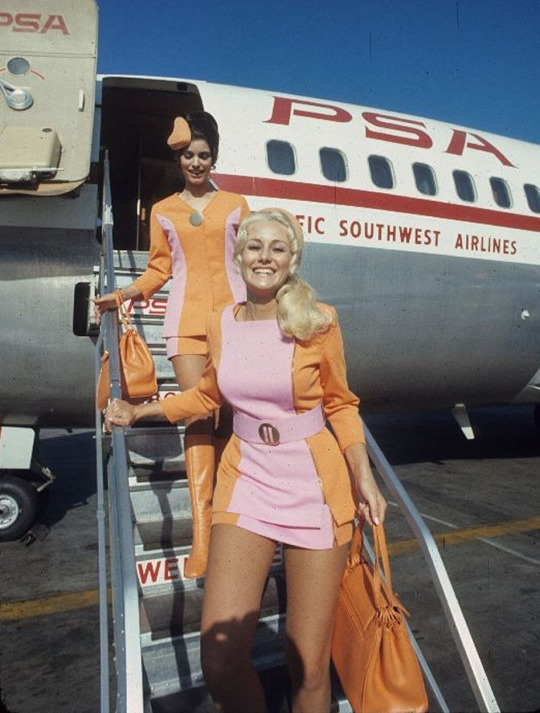
PSA stewardesses. I can't find an original source for either of these pictures, which have been widely spread without context or credit - although significant effort has been made to archive PSA's promotional content, a lot of it is, sadly, free-floating orphaned bits.
PSA's stewardesses wore bright pink and orange uniforms of miniskirts, hot pants, and go-go boots. They were encouraged to joke around with passengers, and so were the pilots. Other airlines at the time were still only slowly losing the unapproachable aura they had cultivated of stiff, sterile luxury and gravitas. PSA would get you where you needed to go without any fuss and they'd charge you half as much for it. And they weren't sloppy, either. Despite their low fares, PSA was incredibly safe, having one fatal accident in a span of time where American Airlines had 16, and even though nostalgia is obviously a factor I've only ever heard glowingly positive accounts of PSA, its service, and its staff.
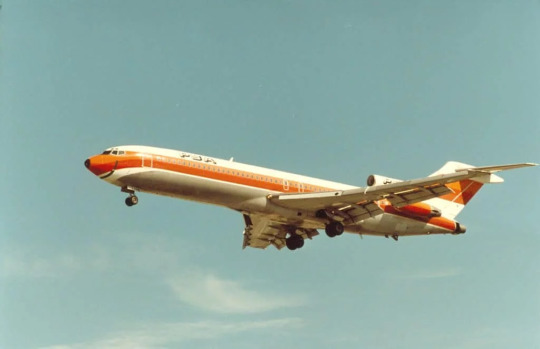
image: Bill Larkins
PSA's fleet was...eclectic. Though they operated a few very popular models, like the Boeing 727 and McDonnell Douglas MD-80 series, a lot of their offerings were somewhat uncommon. The plane in my profile picture is one of their two L-1011 TriStars, another of Lockheed's underappreciated airliners and by far the most advanced wide-body aircraft of its time. PSA was unique in that it operated a jumbo jet, their "Mother Grinningbird", on a route that was not just domestic, but intrastate. They also apparently operated a single Bell 206 helicopter, which I can find no additional clarification on. Lastly, they flew one of the oddest airliners ever built in both function and appearance, the British Aerospace 146.
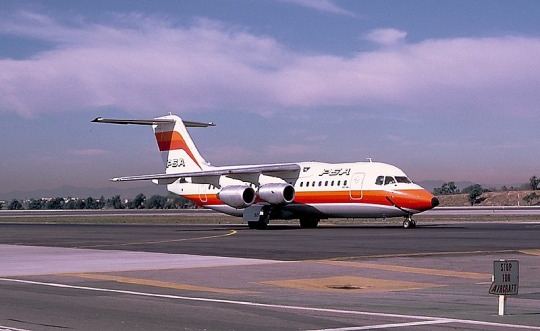
Just your regular high-wing jet. No thrust reversers necessary. Western-made but rocking the Il-76 wing anhedral. Super quiet because the powerplants are based off what you'd put on a helicopter. Seats less people than a 737-200 - six-across layout for maximum discomfort - and flies exclusively puddle jumps...yeah, I think four sounds like the right number of engines.
image: Ted Quackenbush
Across all these planes, they found a livery that worked and they kept going with it. The reason this post is so long is to give context to just how important this livery is. The grinningbirds were what started low-cost carriers, paving the way for the silly names of jetBlue airplanes in a future its founders couldn't even have imagined. The shift to approachability over prestige in airline marketing was PSA's lasting gift to aviation, as were the low fares and the knowledge that a 'budget' airline didn't have to be dodgy or unpleasant - they just had to charge less than TWA and Western.
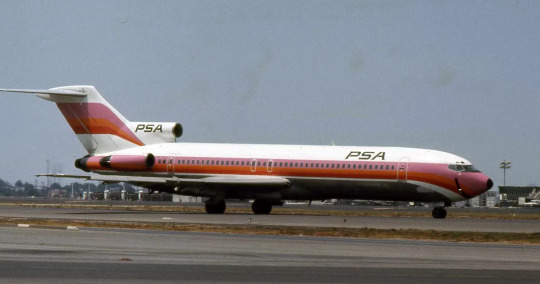
image: Piergiuliano Chesi
PSA's colorscheme was incredibly vibrant. The red and orange colors feel warm and tropical, complementing the California sunshine in which these planes spent their time. Earlier liveries also had a shocking hot pink shade above both, though it was eventually painted over due to issues with paint fading - I think the livery is vastly improved with its presence, but I suppose needs must. Despite the airline serving commuters more than vacationers it puts one in mind of things like beaches and ice cream stands - warm, high-energy things. The sorts of things one might smile about, if they like those things. I hate those things, but these planes make me like the idea of them, because they're just so darn happy to take me there!
The design of the fuselage is incredibly bold despite not using much more paint than any other airline of the day. While the striking colors definitely contribute to the overall look being more than the sum of its parts, I think there's also a few bits of clever design that really elevate the design of the plane.

The tail has a design almost like an inverse hockey-stick. Instead of following the cheatlines for maximum sleekness it chooses to diverge from it, creating a sharp angle that keeps the aerodynamic feeling while feeling fresh from similar designs of the time. By having the thin line from the tail trailing down towards the fuselage it prevents the block of empty space on a regular hockey-stick livery, where the forward portion of the empennage is fully unpainted, and creates a feeling of continuous color and excitement while keeping some staccato punch.
Similarly subtle yet effective are the stripes themselves. They aren't of an equal width - rather, the red stripe is thinner than the orange one, and in planes with the additional pink stripe this one is even wider. It feels a lot more dynamic than simple even-width stripes, feeling almost as if you can see the colors start to mix into each other. The 'mixing' feeling is helped by the fact that the cheatlines wrap under the nose instead of simply ending where they meet. The small painted white line under the main colored ones, above the unpainted metal of the underbelly, creates basically an extra two stripes for the price of one despite being so subtle many people probably didn't notice it.
On its own, the design of the bodies of PSA planes is already good, but it practically ceases to matter when you get to the face.

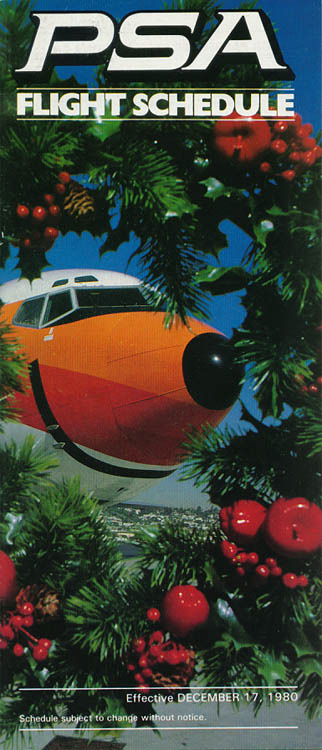
The way the top line of color wraps around the back of the cockpit windows makes it look almost like the plane is wearing sunglasses. And then there's the little painted black nose and, of course, the huge ear-to-ear grin. I don't really know what else to say about this because it's all been said time and time again.
I genuinely don't know how else to express it. PSA's livery was gorgeous and it was perfect for PSA. In all honesty, I don't think it's possible to improve it at all. My one slight criticism is that the actual PSA wordmark, though designed well, is a bit small and out of the way, but to be totally honest it's barely necessary. You see the smile and you know exactly who that plane is flying for.
PSA gets a PSA+.
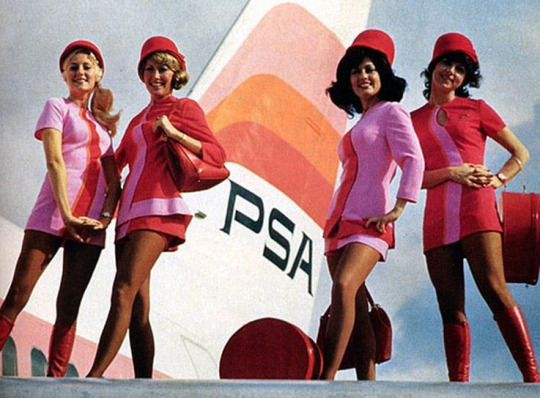
So what happened to PSA, if they were so successful? Did an economic shift catch them off-guard? Did some demographic evolution rob them of their old customer-base? Did a change of management result in a new owner running the airline into the ground? Did it have anything to do with the fact that the one time they were involved in an accident it spent eight months as the deadliest crash in US history?
Nope. They got bought out by USAir because they wanted more routes on the West Coast.
Yeah. That's the story. Neither a bang nor a whimper. They left one morning and didn't come back. That was the end of PSA, the first-ever low-cost carrier, California's most beloved airline, and one of the best-designed liveries in airline history if not the very best.
There is, however, one final twist. USAir eventually was sucked into the gaping maw of American Airlines. With this merger American Airlines also inherited the rights to PSA's IP. In classic fashion, they created a wholly-owned subsidiary by the name of PSA Airlines, just to make sure nobody else could get the trademark.


Under the iron fist of first US Airways (USAir's eventual rebrand) and later American Airlines, we were allowed one last grinningbird - an Airbus A319-100 registered N742PS. It's strange, seeing the PSA livery on a model of airplane they never operated. It's a rare example of the design on airframes that have that rather distinct 'default' modern empennage, all sharp and tall with no t-tail or third engine. The implementation could take some notes and the colors look bizarrely plastic, but I will never stop loving her no matter how much they take from her. How could I not, with that smile?
Unfortunately, in April of this year she was re-painted to a standard American Airlines livery. Although the Allegheny and Piedmont heritage liveries were removed at the same time, I almost don't even notice their absence because of the loss of our very last holdout from a much more colorful time and place. Part of me feels a sort of ripping-the-bandaid-off relief at it. American Airlines shouldn't get to parade around the skin of a much better livery worn by a much better airline. That isn't theirs; they didn't earn it. And there's no way to rebuild PSA now that times have changed and the industry is unrecognizable from the days when a ticket from San Diego to Burbank cost $9.99. All the same, the loss of yet another smile hurts. There's no way it wouldn't. And at the end of the day it makes me feel a little dead inside just imagining the mindset of the American Airlines executive who walked by her in the hangar and instead of smiling back gave the order to paint her white. And that day, the sky got a little less colorful and a lot sadder.
Maybe, in a strange sense, the way it happened is better. Nobody ran PSA into the ground. They did not cause some sort of reputation-ruining accident through willful negligence. Their customer service did not decline until they were widely grumbled about. They didn't die infamous for poor safety and loose morals like Pan Am, or splitting at the seams and betraying their reputation like Chalk's Ocean Airways. No, I don't think an organic shriveled going-under would have held any more dignity than this. I think the ending PSA got is as graceful as the ending to something like PSA could be. There is no end to the glory days which forces itself into our memories. There is no decline. No sunset to fly off into. There is a loss to mourn, but no accompanying moment to curse. Lost at sea, ship never found, nothing to imply a terrible fate; all we know is the poor sailors aren't here anymore.
Maybe it's not universally known to people who aren't interested in subjects that bring them close to it, but to those of us who love planes PSA is truly special. Its quiet apotheosis has made it synonymous with the very best an airline could be. The joy of a time where a regular person could finally afford their first plane ticket and be greeted by colorful people who talk to them like friends, where even the planes are smiling, is encoded into the DNA of PSA's remnants, into every anecdote told by an aging former stewardess and into every Polaroid taken of one of those smiling planes parked on a sunny California tarmac. It was there, and then it was a distant echo of warm breezes and idle chatter that feels almost close enough to reach out and touch. PSA never died. One day it was flying passengers to their destinations, planes smiling their same smiles. The next day it was fond memory, already graduated to the distant sunny shores of nostalgia.
youtube

#tarmac fashion week#grade: a+#region: north america#region: united states#era: 1960s#era: 1970s#era: 1980s#pacific southwest airlines#requests#defunct airlines#regional airlines#double sunrise#long haul#galley gala
107 notes
·
View notes
Text

found this while cleaning out a desk, how I’ve missed you so.
#airtran#early 2000s#Boeing 717#mcdonnell douglas#McDonnell Douglas MD-95#defunct corporations#defunct airlines#y2k#y2k nostalgia
6 notes
·
View notes
Text
british midland international but the logo sphere thing is that one flushed emoji meme

0 notes
Text
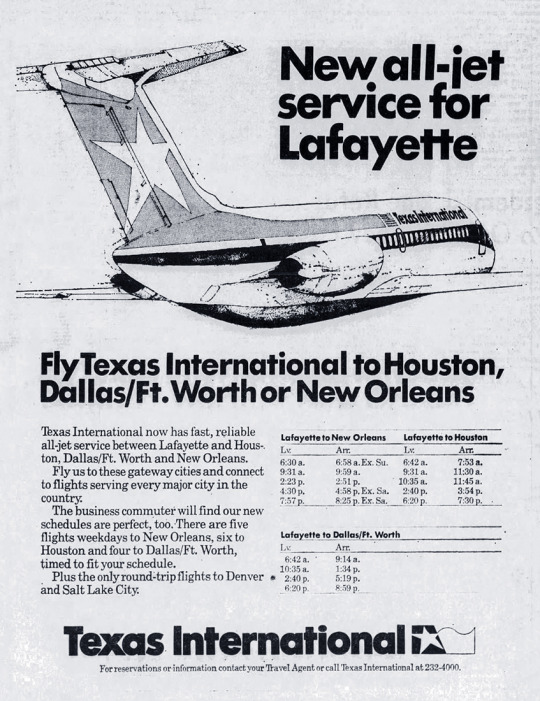
Texas International’s new all-jet service for Lafayette.
#texas international#texas international airlines#vintage air travel#air travel#air lines#continental airlines#defunct airlines#douglas dc-9
1 note
·
View note
Text
Watch "Death of an American Dream: The Pan Am Story (1992, Documentary)"
Watch “Death of an American Dream: The Pan Am Story (1992, Documentary)”
In the beginning of the documentary they interviewed a pilot just after Pan Am went out of business. He was 53 years at the time and afraid of the future. He would be in his 80’s now… I hope everything turned out OK for him.

View On WordPress
0 notes
Text


First Flight - Air Mail AM-77 Burns to Boise
I learned something I never knew because of this envelope.
In the fall of 1959 West Coast Airlines added service to Burns and Lakeview.
The Kelley Act, also known as the The Air Mail Act of 1925 was the start of Air Mail service in the USA. This was referred to as a Contract Air Mail route or CAM. CAM 1's initial flight was on July 1, 1926 between New York and Boston Massachusetts with an interim stop in Hartford Connecticut.
Postal mail covers carried on the inaugural flight between each point of landing and take-off are collectible and are known as CAM-1 covers. Source: aerodacious.com
West Coast Airlines was awarded contract AM-77 for the Northwest originating out of Seattle. By this time the contracts had been revamped and the C of CAM was dropped. The first flight for AM-77 was on December 5th, 1946 and was designated 77S1.
Over the years additional airmail routes were approved and added. According to the Airpost Journal of September, 1959 additional extensions of AM-77 were granted. In an article by William R. Ware the additional service locations and routes are detailed.

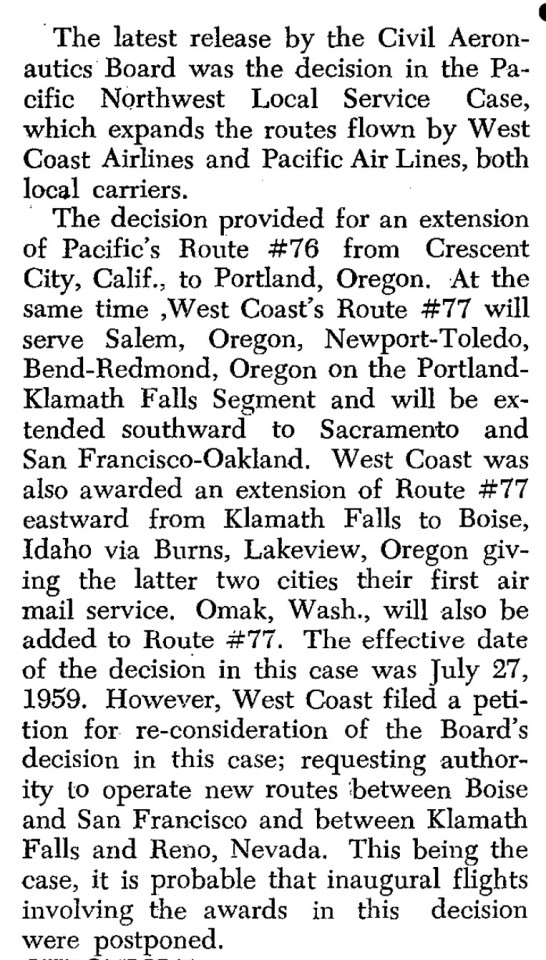
On September 15, 1959 the inaugural flight was made and routes 77E59, East to Boise and 77W59 West to Lakeview made their maiden flights using a Fairchild F-27 turboprop aircraft. A year previous to this flight West Coast Airlines purchased the first Fairchild F-27 for use in the United States. Depending on the source West Coast had 13 or 14 of these planes over the years.
youtube


La Grande Observer, La Grande, Oregon, Tuesday September 1, 1959
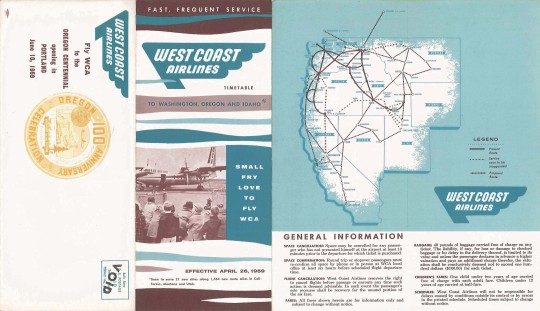
West Coast Airlines Proposed Routes April 1959
Source: timetableimages.com

West Coast Airlines Finalized Routes February 1960
Source: timetableimages.com
West Coast Airlines service ended to Burns in between 1966 and 1968.
#la grande observer#vintage newspapers#oregon#eastern oregon#harneycounty#the great pnw#the old west#oregonoutback#pnw#oregon outback#burns oregon#harney county#pacific northwest#airlines#defunct airline#west coast airlines#west coast#timetable#air route#fairchild f-27#Youtube
4 notes
·
View notes
Text

silly little inside joke for my bag
#the haters will say it’s because it’s a defunct california airline that got bought out by american.#real ones know the reference.#em speaks
7 notes
·
View notes
Text
Way back in 2004-ish, I created a Gmail account. It was in beta and was invite-only, so it was the 'cool' thing to have.
One of the claims was that you would never have to delete an email. Fastforward to 2022 where Gmail constantly tells me I'm at 91% capacity and must delete emails or buy their cloud storage. I refuse to buy storage, so I'm going through my emails. I mass deleted a bunch of things (anything from Circuit City, daily recipes from any number of sites, etc), but I don't want to delete legit order emails, so I'm now looking at 2010-2012 in the Promotions tab.
Some gems include: "Get your grad an iPad 2", "Happy Holidays from Continental Airlines", "Life improvement is on its way! The 2012 IKEA Catalog arrives soon", "Are Your Garmin Maps Up To Date?", and "Don't lose your dividend miles" from US Airways.
4 notes
·
View notes
Text
youtube
#MPC Flight recreations#Youtube#Youtube channel#DC-8#classic jets#olden days#Douglas aircraft#Douglas DC-8#FineAir#Defunct airliners#Air accidents
0 notes
Text
The Other Kind of Jets: A Cursed Airplane’s Effect on the National Hockey League
Road games are undeniably an important part of an NHL team’s schedule. Finding ways to win on the road is crucial, and that means considering everything up to and including the mode of transport. Most NHL teams charter VIP-configured large passenger aircraft for travel (with the notable exception of the Detroit Red Wings, who share use of the last remaining McDonnell Douglas MD-81 with the Detroit Tigers); this reduces costs for teams, as they don’t have to be responsible for aircraft maintenance and the planes are free to transport other teams around during homestands. But one particular plane has been having an unfortunate effect on teams this season, leading to speculation that this aircraft might be somehow cursed.
N803TJ is a Boeing 737-400 owned and operated by aviation charter company iAero Airways (previously Swift Air). It is a 29 year old aircraft, first delivered to LOT Polish Airlines in 1993 under the registration number SP-LLB. Aside from a four month lease to AeroSvit Airlines (a now-defunct Ukranian airline) from December 2003 to April 2004, it remained in service with LOT until its withdrawal from the LOT fleet on November 6, 2012. Swift Air purchased the aircraft in 2013, reconfigured the cabin for VIP charter use, and registered it in the United States as N803TJ.
It is unknown at which point the aircraft became cursed—or indead, if it has always been a blighted beast.
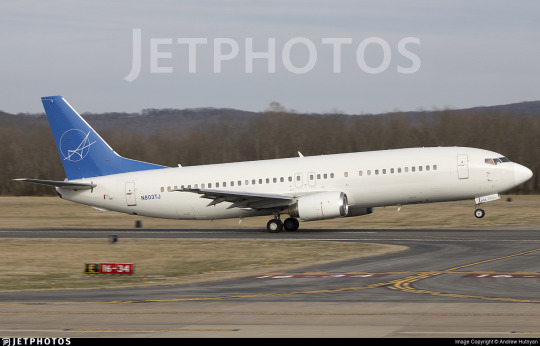
Fig. 1. N803TJ during takeoff at Fayetteville Drake Field (FYV) in Arkansas in February 2020. It was transporting the University of Missouri men’s basketball team, who had just lost to the Arkansas Razorbacks. Photo by Andrew Hutnyan.
But how do we know that N803TJ is cursed?
The record for road games across the NHL at this point in the season is 69-75-11, or a points percentage of 0.481. This is slightly lower than the 0.500, indicative of home ice advantage, but teams are still winning a nice amount of road games.
The record for road games when N803TJ is involved in transport, however, is a stunning 1-9-0, or 0.100, well below the league average. Only one team in the league has a worse road percentage at this point (the Ottawa Senators, who have lost all four of their road games so far). The Pittsburgh Penguins, who relied on N803TJ during their western Canada road trip, proceeded to lose four games straight on that trip and have struggled ever since. Additionally, when the Boston Bruins seized the sole road victory for a team transported by N803TJ, their opponent was the Penguins, who were coming off that long road trip on N803TJ, and though the Bruins snatched an overtime victory, they still had two players leave the game due to injury. N803TJ’s curse is not easily thwarted.

Table 1. Travel around the NHL using N803TJ as of the morning of 11/03/2022. The Bruins play an N803TJ-affected game in New York later today.
So what can teams do about this? Well, for one, they can avoid N803TJ. The majority of the league charters flights either from Delta Airlines or from Air Canada, and as such those teams have no reason to worry about an aircraft owned and operated by iAero Airways. However, for those teams that do charter from iAero, there is little to be done to avoid N803TJ, as aircraft are dispatched as needed and refusing to use an aircraft would not be met kindly by iAero due to the negative impact on their flight coordination and resource management. Affected teams would be advised to look into methods of cursebreaking and protection instead, for though N803TJ and its curse might be unavoidable, it is not all-powerful and the effects can certainly be mitigated.
Perhaps someone will break the curse this season. Until then, keep an eye on N803TJ and remember: where the Blighted Beast goes, sorrow shall soon follow.
#this is mostly a joke#aviation#hockey#pittsburgh penguins#boston bruins#columbus blue jackets#nashville predators#<- the teams affected thus far#the blighted beast#edit: please reblog this instead of the stolen version
218 notes
·
View notes
Photo


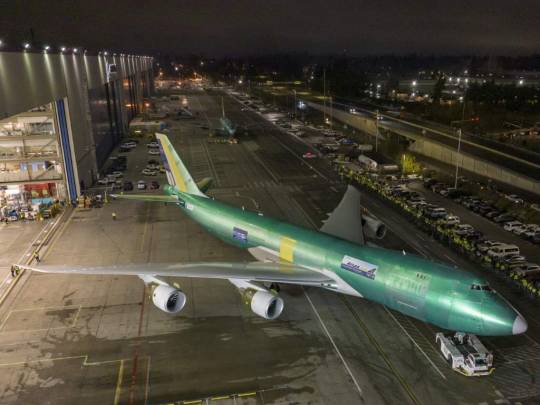

“Queen of the Skies”
Nearly 55 years after Boeing started production of its jumbo 747 jet, the last model of the iconic airplane left the company’s factory in Everett on December 7, 2022 closing a chapter in aviation history.
Back in the 1960s, Boeing engineer Joe Sutter designed the 747, the world’s first twin-aisle airplane, to carry 400 passengers or more on long-haul flights. Production began in 1967, and the first plane entered service with Pan Am in 1970.
For decades, the 747 was celebrated as the “Queen of the Skies” — and it played supporting roles in movies ranging from “Airport 77″ and “Air Force One” to the 2020 sci-fi movie “Tenet.” More than 1,500 of the planes were produced.
But as the aviation industry came to focus on fuel efficiency and point-to-point route planning, the business model for the passenger 747 became obsolete. In recent years, the 747 has increasingly been used for cargo rather than passengers, and the baton has been passed to other wide-body jets such as the 767, 777, 787 and 777x.
Although it’s the end of the production line for the 747, it’s not yet the end of the line for the planes. Existing 747s, including the one that rolled out on Tuesday, are expected to stay in operation for decades.
And the 747s are due for another turn in the spotlight a few years from now: Two 747 jets that had been built for a now-defunct Russian airline are currently being converted for presidential Air Force One service, with delivery set for the 2026-2028 time frame.
Courtesy: Boeing Photo / Paul Weatherman
#art#design#icone#legend#queen of the sky#boeing#jumbo#Boeing 747#airplane#airport77#tenet#air force one#aircraft#Boeing 747-400#paul weatherman#jumbo jet
122 notes
·
View notes
Text
No. 25 - BWIA

@international-nerd asked me to discuss BWIA! I was very excited about this request when I first read it, and now I'm very excited while I write this. BWIA's 2000s livery, which is what I'll be focusing on here, is one that definitely stood out on the tarmac.

It's rare that I can emphatically say this about an airline livery, but it's sort of in a category of its own. If more carriers approached livery design like BWIA, I probably wouldn't have been frustrated enough with the state of things to make this blog in the first place, because their livery is the polar opposite of the timid, corporate, and generic design we expect from airlines.

I like this picture a lot because it looks like she's saying hello to you. Like a cat approaching to sniff your hand.
First taking to the air in 1940 under the name British West Indian Airways, BWIA was also known at various points as BWIA West Indies Airways, BWIA International Airways, or 'Bee-Wee'. Its website was bwee.com. I have begun saying 'bweeeeee......' to myself under my breath now whenever I'm alone.
BWIA was founded as a private company, then became a BOAC subsidiary, and then was rapidly acquired by the government of Trinidad and Tobago. From 1961 until its ultimate demise in 2006, BWIA was the flag carrier of Trinidad and Tobago and became the largest carrier in the Caribbean, serving destinations in North America, South America, the Caribbean, and Europe.

Back in the day they had this...boring standard thing, but by the 80s they expanded their horizons to the other half of the color wheel, picking up a recognizable teal-and-bright-yellow color scheme. Its various jets continued to wear this livery until around 2000.
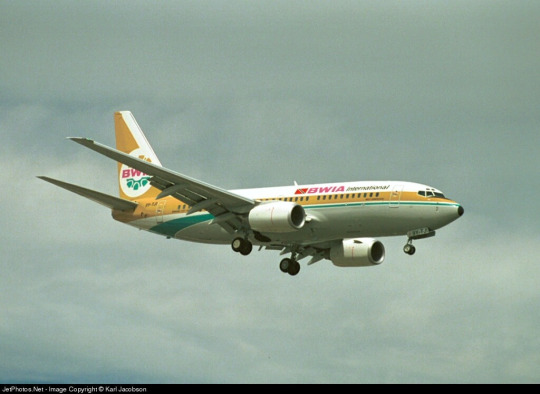

Sure, one image could have sufficed, but I'm far too weak to resist the allure of putting a really cobby-looking plane next to a comically long-looking plane.
The yellow and teal was a step in the right direction, but in 2000 BWIA decided it was time to unleash their true power on airports across the world. And the result is the subject of this post.

Now there's a livery worth talking about.
Seeing images of this livery makes me feel temporally strange. This is an airline which I technically overlapped with, in the sense that I was alive while BWIA existed, but I'm just inherently too young to remember that. There's definitely a chance I saw one of these striking planes in person and just don't remember it because I was five or so years old, and that's a very strange thought. I wish I had managed to see one, and had held onto the memory somehow, because I love these planes.
Do I miss the hot pink lettering from the previous livery? Yes, a little bit. I won't deny that. But if I hadn't known it was there I wouldn't have had that thought, so I don't think that's anything to hold against them.

I think BWIA is a really good place to pick up after this week's first post, Icelandair, where I discussed flag carriers' branding and the fact that it should reflect the country it represents. Trinidad and Tobago's contributions to music are gigantic. It's the birthplace of calypso, though calypso is far from the only genre and far from the only tradition which originated there.
BWIA's logo is a stylized steelpan, a musical instrument invented in Trinidad and Tobago which I could talk about on its own for quite some time if I weren't insisting to myself that this post has to be about airplanes and not music, but it's a choice of logo that makes it immediately clear that this is an airline which represents a group of people rather than just a flag. If the culmination of a flag carrier's mission is to make a case for why it's flying to a place you should visit, this is an incredibly effective way to do that. Trinidad and Tobago is a place where music is born. It's not just islands with beaches, it's islands with people and if you go there you will have experiences you could never have anywhere else.
In terms of flag carrier logos, it's up there among my favorites. The older 2D version is a little harder to immediately identify as a steelpan but the 2000-onward 3D version is very clean and very uniquely BWIA's. It adds more detail but it never becomes cluttered. The steelpan shape and the teal-and-yellow colors are both distinctive on their own, and combined they make planes that are impossible to mistake for any other airline.
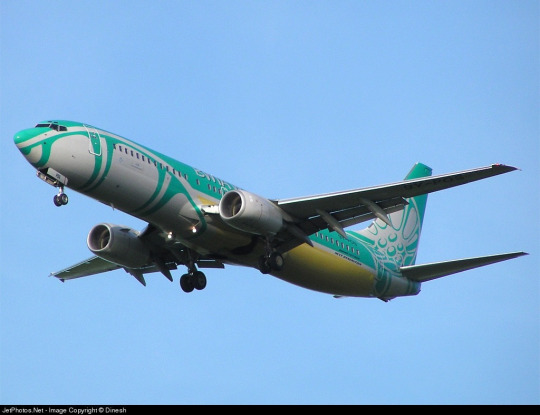
The steelpan logo is prominent both on the tail and wrapped around the bottom of the fuselage, starting about midway down the ventral fairing and ending just below the nose. I really admire BWIA's choice to go with white-on-blue rather than the blue-on-white any other airline would have chosen. It instantly elevates the livery from doing something interesting with the placement of its shapes to doing that and also stubbornly refusing to even approach Eurowhite.

The use of white where it is used is very nicely executed, though. It allows the overall design to maintain a lightness by avoiding black outlines, while preventing the sort of overt eyestrain that comes from putting yellow directly on this sort of light teal. Instead, it elegantly uses the yellow as an accent on the back half of the fuselage. It's difficult for me to even articulate why this works so well, but it just does. The colors look harmonious together despite never mixing, and it's not the sort of place a secondary color would normally be isolated, which I think might be why it's so brilliant. It's a really nice accent to the rest of the plane, preventing the flatness which could result from a livery made entirely of a light color and plain white, while not impinging on the steelpan logo. It draws the eye and then takes a step back to let it experience the rest of the plane, and when you take a step back and appreciate the livery as a single unit it prevents any of that detail from being lost in a blue-and-white blur.
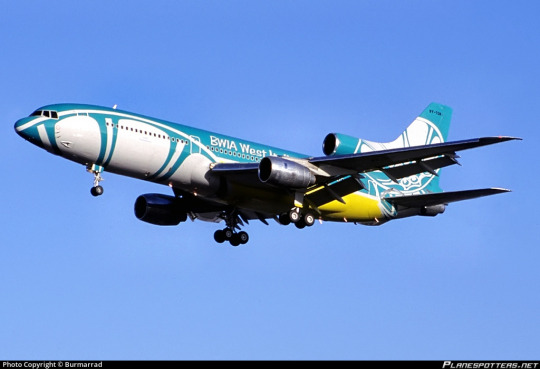

As with many liveries, I think BWIA's looks its best on a TriStar. That might be because the larger empennage lets you see more of the steelpan logo, but there's something so nice about the way the yellow peeks out from under the wing that reminds me of birds with bright yellow underbellies.
I think the main thing that sticks with me after looking at BWIA planes from every angle I can find images for is that this livery exemplifies a style of design that is the exact opposite of what makes most liveries so disappointing. This feels like a livery designed by someone who had never seen another airline livery before, who was sat down with some pencils, a color scheme, a logo, and an identity, and told to find a way to reflect it in the shape of the airplane. In so many of my other posts I compare liveries to each other, with the worst cases merging into uninspiring slop of aughts Delta clones and late 2010s Lufthansa clones and so forth. BWIA just didn't participate in any of that. This livery is hard to put words to because it's nearly impossible to compare to any other livery - in a good way. Most airlines' special occasion liveries don't have a fraction of this excitement.

This might sound a little lofty, and I don't mean to say that BWIA is what airlines should strive to directly emulate (in fact, by doing so they would sort of be doing the opposite of what BWIA did when they released this into a world full of Air France and United), but BWIA here has done what general relativity did to physics. Not so much a different equation, but a different state of mind. Taking what has always been treated as numbers and saying that it makes a lot more sense to think of it as fabric. And what I ultimately think is the most important outcome of these choices is that I can imagine any number of people watching other planes on the tarmac, bored out of their minds, snap out of their stupor to get a closer look when they see a BWIA plane roll by.

We unfortunately lost BWIA in 2006. It was for regular boring financial reasons, a similar situation to the more recent death of Alitalia where the government simply can't keep pumping money into something which has never turned a profit and has to start over with a new airline. I'm not going to talk about its successor, Caribbean Airlines, except to say that obviously I think it's a gigantic downgrade. Frankly, I could really like Caribbean Airlines and it wouldn't matter. If an impeccably designed livery is equivalent to someone who can answer any question you have about the body of physics scholarship, BWIA is equivalent to the sort of theorist who gets fundamental laws named for them.
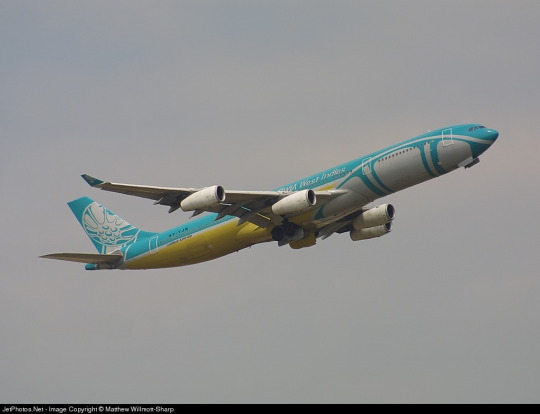
A+, and goodnight.
#tarmac fashion week#grade: a+#era: 2000s#region: caribbean#region: trinidad and tobago#bwia#flag carriers#defunct airlines
47 notes
·
View notes
Text
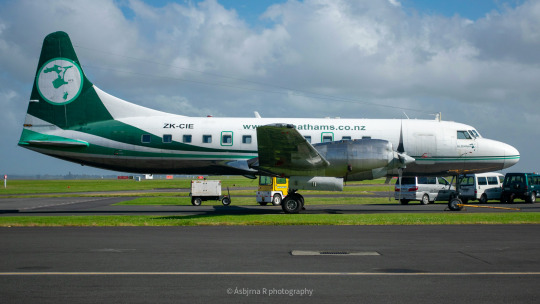
ZK-CIE [Convair CV-440/580] seen at Air Center One (2020).
New to Union Oil, CA in 1957, and registered as N98G, it was built as a Convair CV-440-83 c/n 399. It was sold to Gulf Oil Corp a month after delivery and was rebuilt to a CV-580 in 1961.
After being re-registered three times (N98GL, N57RD, N565EA), it ended up in Alaska working for ERA Aviation Inc by 1967.
It was wfu in 2005 and sold to Air Chathams and flown direct to New Zealand. It was wet-leased to Peau Vavaʻu, Tonga, for a year in 2006. It was then subsequently wet-leased to Air Fiji [NB: seemingly not to be confused with Air Pacific, now Fiji Airways] in 2007. It then spent time with Chathams Pacific [Air Chathams' Pacific Island operations] and Real Tonga Airlines during the 2010-14 period.
It then worked dutifully back in New Zealand until 2022 when it was scrapped and its nose-section purchased by the recently defunct Epic Brewery, Onehunga.
Air Chathams was the last operator in the world to retire the Convair and did so mostly due to new noise regulations imposed by the CAA. This is exactly how the Tasman Cargo Airlines (trading as DHL) 727F was retired a decade earlier.
9 notes
·
View notes
Text

McDonnell Douglas MD-11 VARIG
Registration: PP-VTK
Type: MD-11 ER
Engines: 3 × PW PW4462
Serial Number: 48540
First flight: Apr 1997
VARIG (acronym for Viação Aérea RIo-Grandense, Rio Grandean Airways) was the first airline registrated in Brazil. The company was founded on 7 May 1927, in Porto Alegre, by Otto Ernst Meyer-Labastille, a German aviator, who immigrated to Brazil in 1921. From 1965 until 1990, it was Brazil's leading airline and virtually its only international one. From 1997 to 2007, Varig was a member of the Star Alliance. In 2005, Varig went into restructuring, and in 2006 it was split into two companies. First from it – Flex Linhas Aéreas, informally known as "old" Varig, was heir to the original airline – now defunct. And second one – "new" Varig, is a new company, fully integrated into Gol Airlines.
Poster for Aviators.
aviaposter.com
7 notes
·
View notes
Text
The Last Time
As much as I am a futurist, I think it is also worthy of our time to look long into the rear view, to reflect on how far we have come, how much change has happened without our really having noticed, and how lives are different from the way they were.
And so I give to you my recurring essay on “The Last Time.” I don’t intend to be sad or morose, although that can certainly happen, such as when we recall the last time we saw a person, especially loved ones. No, I am more concerned in this exercise to reflect on the things, the artifacts, the services, of a society that we no longer utilize, but at the time of our “last time,” we just didn’t realize it.
Worse yet, the longer you live, the longer this list grows. It is inevitable as technology advances—and so do you—that your inventory of things and services no longer consumed gets a little longer each year.
Take, for example, the last time you used a travel agent to buy an airline ticket or book a rental car. Although I cannot pin down the date, I am going to estimate it was around 1997, when Travelocity was riding high. I didn’t think about the significance at the time, until I saw the son of the then-defunct travel agency working the front desk of an airline at the Amarillo airport. Geez, did I help put him out of a job?
It is much the same for hotel reservations, which I now do via a mobile app on my phone. I reserve, pay, and get a digital key so that I do not even have to interact with the front desk. I just go to my room.
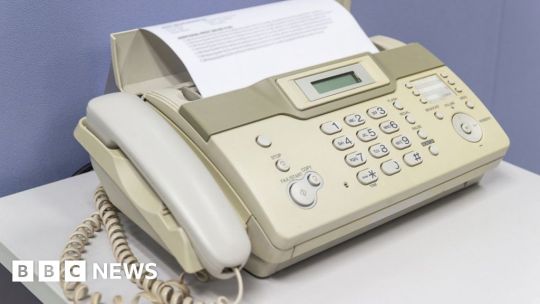
My tech history is littered with products, many of which I still keep in a box or two “just in case,” including 5 1/4” floppy discs, 3 1/2” discs, ZIP discs, CD-ROMs, and so forth. I have every cable imaginable. And what about the office fax machine, a staple rendered obsolete in recent years? It has been a long time, and a few years ago, I learned it had been an even longer time when I went into the COB office to fax something. They laughed when I asked where the fax machine was. They told me to just scan and email it.
OK.
I could go on, and I will. Landline telephone? Payphone? Paper map atlas? I think it is still a good skill to know how to read a map, and not just rely on Google to bark out turn-by-turn directions, but it is pretty rare when I bring out that huge booklet. I used to buy a new atlas every year. I bet it has been eight years or more now.
Let’s look at some other tech items. Did you ever own a black-and-white television? My family had one up until the early-1970s, and the small portable I took off to university in 1977 was also B/W. But that’s the last I remember. And what about your phone? I suspect that most of you are so young that you have never owned anything but a smartphone, while I have recollections of several flip phones and their varietals, as well as a predecessor bag phone, which weighed about five pounds.
There are other things in our lives as well. For example, it may be the last drink you took, the last cigarette you smoked, the last meat you ate. Shedding old habits for new can be hard, and I bet those are the ones that stand out most in our memories, because they all involve things we put in our mouth.
Yesterday I had occasion to write a check. I looked through the registry, and noticed it had been more than two months since the previous, and three months before that one. For a person who used to write checks all the time, I have almost phased it out of my life. Now we Venmo, Zelle, and other methods that have become verbs, or just pay our bills electronically. Truth be known, that’s how I do most of my bill pays, but this one in particular added a fee for credit cards, so I went old school. The tax assessor can be like that.
For that matter, when was the last time you actually swiped a credit or debit card? We have replaced all that with chip readers or tap-and-pay, and now hand scanning at Whole Foods. Swiping is so 2010.
The crazy part of all this rear view remembering is that few among us ever knew what was happening. We were making implicit decisions, not explicit, and so it could not be known until later that we had just passed a turning point. Even when I eventually got rid of the typewriter my parents had gifted me for high school graduation, I did not realize I would never ever use one again.
I challenge you to consider your growing list of things for which the last time has already passed, and most likely completely under your radar. You have all lived long enough, even in your short lives, to have experienced the march of technological progress.
You just don’t realize it. Think on it, and share in the comments.
Dr “Last Dance” Gerlich
Audio Blog
2 notes
·
View notes
Note
hey juju if you don't mind sharing, whats your favorite:
1. airplane
2. airline
3. airport
🏈.
(I've never been on a plane so idk the wonders)
OH SUCH A SWEET ASK….. thank you for enabling me SHSGGSHS i’m always happy to talk about these things here 🛬 (oh btw side fun fact planes land on their back wheels/landing gear first and then touch their front wheels down second so this emoji is actually crashing, not landing 👍)
1) it’s a bit of a “basic pick” because it’s by far the most popular and recognizable commercial jet but my fave is the boeing 747-400….. it’s the best-selling and most widespread of all the 747 variants with about 700 sold. the 747 series in general is credited with democratizing (the process of making technology more accessible and/or affordable to the general public) air travel so we love a good groundbreaking historical development 👍
2) my fave modern airline is delta (they’re all i ever fly so i’m loyal LOL) and my fave historical airline is pan am… they went defunct in 1991 after trouble adapting to the post-airline deregulation act era (simply put this means they had trouble adapting to increasing competition from other airlines) as well as troubles from the 1970s oil embargo 💔 i adore them though my 1970s pan am safety cards are my favorite in my collection!
3) ATL NO CONTEST I LOVE A GOOD ATL… yeah i’m biased because (1) i love georgia as a state and (B) ATL is delta’s primary hub LOL but i love it so much. i always have a great time when i’m there— last time i was there i went over and stared at the dreamliners in their international concourse lol

#genuinely thank u for asking it’s so nice to talk abt these things GAGAGGA#vox do you want me yet#🏈 anon#chats
10 notes
·
View notes